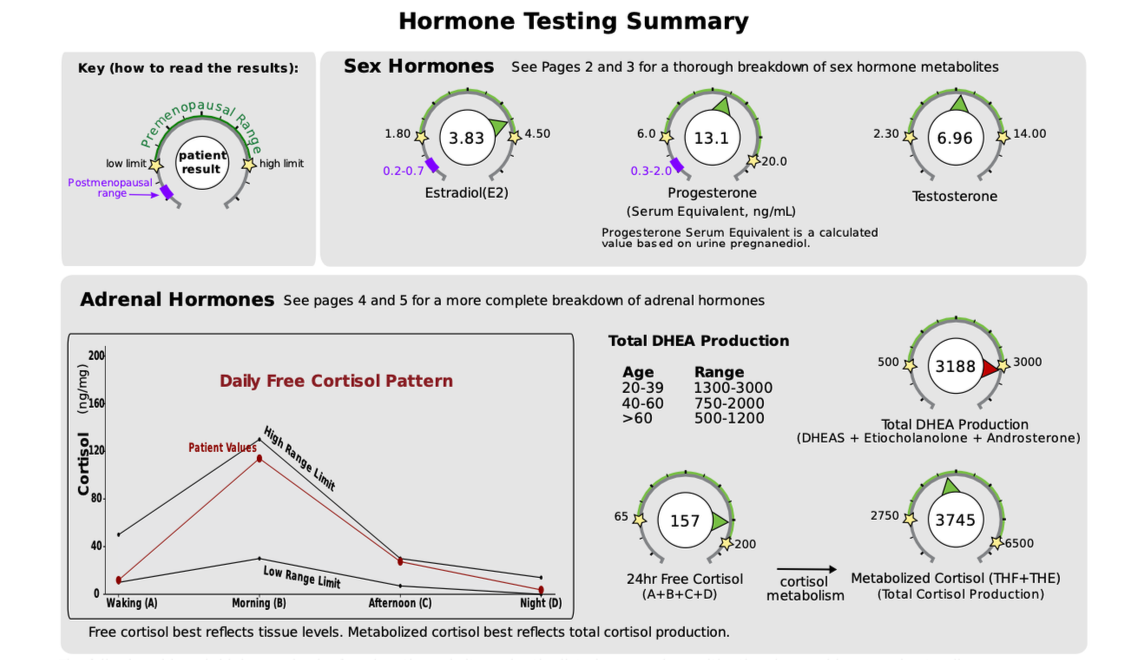How Functional Testing Changes the Game for Your Health
This blog post may contain affiliate links. At no cost to you, I may earn a small commission off products purchased through these links.
The information in this blog post is meant to be educational and is not meant to be a substitute for medical advice.
If you’ve ever gone to your doctor with fatigue, hormone symptoms, or digestion struggles only to be told “your labs look normal” — you’re not alone.
I hear this story all the time. You feel like something is off in your body, but the conventional tests come back within “normal range.” It’s frustrating, invalidating, and leaves you wondering: Am I just imagining things?
Here’s the truth: you are not imagining it. Your symptoms are real. The problem is not you, it’s the lens through which your health is being evaluated.
That’s where functional testing comes in.
Functional testing looks at your body differently than conventional labs. Instead of simply identifying whether you have a disease, functional testing is designed to evaluate how your body is functioning day-to-day, where imbalances are happening, and how different systems are working together (or not).
This is why in my practice, I use functional tests like the Hair Tissue Mineral Analysis (HTMA) and the DUTCH Hormone Test, because they go deeper than “disease or no disease.” They help us see what’s really going on behind the scenes so we can create a personalized plan that actually supports your body.
Let’s break down the difference between conventional and functional testing and then I’ll show you why HTMA and DUTCH are two of my favorite tools for getting to the root of health concerns.
Conventional vs. Functional Testing
Both types of testing have their place, but they’re designed for very different purposes.
Conventional Testing
When you go to your doctor for bloodwork, here’s what’s typically happening:
The test is designed to rule out disease.
Your results are compared against a wide reference range (usually based on averages of the general population, not necessarily healthy people).
If your results fall within “normal,” the doctor says you’re fine. If they fall outside, a diagnosis may follow.
This system works well for detecting serious issues like diabetes, liver disease, or thyroid failure. But what if you’re living in the in-between, not sick enough to be diagnosed, but not well enough to feel good?
That’s where many people get stuck. Conventional testing can’t always explain fatigue, hormone imbalances, poor sleep, or why your digestion feels off even when your labs are “normal.”
Functional Testing
Functional tests are built differently. Instead of looking only for disease, they measure how your body is functioning and whether key systems are balanced.
The focus is on optimal ranges, not just “normal.”
Results are interpreted in context (looking at patterns, ratios, and interactions, not just single numbers).
The goal is to find imbalances early, before they turn into bigger health issues.
Think of it this way: conventional testing asks, “Do you have a disease yet?” Functional testing asks, “How well is your body operating, and what can we do to support it?”
Why I Use Functional Testing in My Practice
When I sit down with a client, I want to do more than manage symptoms. My goal is to understand why those symptoms are happening and what your body needs to get back into balance.
Functional testing gives us that window of insight. Instead of guessing or applying a one-size-fits-all plan, we can see exactly what’s going on inside your body and tailor your nutrition, lifestyle, and support accordingly.
Two of the most powerful tools I use are the Hair Tissue Mineral Analysis (HTMA) and the DUTCH Hormone Test.
The Hair Tissue Mineral Analysis (HTMA)
Minerals are the spark plugs of your body. They are essential for energy, thyroid function, blood sugar balance, nervous system health, detoxification, and hormone production. When your minerals are off, you feel it, even if your bloodwork looks “normal.”
The HTMA test uses a small hair sample to measure mineral levels and heavy metals. Why hair? Because unlike blood, which shows what’s happening in the moment, hair reflects longer-term trends in the body over about 2–3 months.
What HTMA Shows Us
With HTMA, we can see:
Your levels of key minerals being deposited into the soft tissues of the body, like calcium, magnesium, sodium, and potassium.
Ratios that reveal how your thyroid, adrenals, hormones and other important body systems are functioning.
Whether your body is in a “fast” or “slow” metabolic state. This also helps tell us how much protein, fat, and carbohydrates your body needs on a day to day basis.
Heavy metal exposure and how your body is handling detoxification.
This test is especially powerful for clients dealing with fatigue, thyroid issues, hormone imbalance, poor stress resilience, or stubborn weight changes. It helps us uncover patterns that bloodwork might miss.
For example: you could have “normal” thyroid labs, but your HTMA might show a sluggish metabolic pattern and mineral imbalances that explain why you’re tired and struggling to lose weight. That’s the kind of insight that changes everything.
The DUTCH Hormone Test
Hormones are often at the center of health struggles — PMS, infertility, PCOS, menopause symptoms, fatigue, mood swings, low libido, the list goes on. But a simple blood draw doesn’t always tell the full hormone story. That’s where hormone testing for women can be so insightful.
The DUTCH Test (Dried Urine Test for Comprehensive Hormones) is one of the most advanced tools we have for understanding hormone health. It measures not only your hormone levels, but also how your body is metabolizing them.
What DUTCH Shows Us
The DUTCH test provides a detailed picture of:
Estrogen, progesterone, and testosterone levels.
Cortisol patterns throughout the day (your stress hormone rhythm).
How your body breaks down and detoxifies hormones.
Melatonin, DHEA, and other key markers related to energy and sleep.
This is crucial because symptoms don’t always come from having “too much” or “too little” of a hormone. Often, the problem is in how your body processes and clears them. For example, two women might both have “normal” estrogen levels, but if one of them is metabolizing estrogen down a pathway that creates inflammatory byproducts, she might experience estrogen dominance symptoms like heavy periods or breast tenderness.
The DUTCH test gives us the roadmap to see where that imbalance is happening. From there, we can use targeted nutrition and lifestyle strategies to support hormone balance naturally.
Why These Tests Work So Well Together
HTMA and DUTCH testing are powerful on their own, but when combined, they create an even deeper picture.
Minerals drive hormones. If your minerals are depleted or out of balance, your hormones will struggle to regulate.
Hormones influence minerals. Stress hormones like cortisol affect how your body uses sodium, potassium, and magnesium.
Together, they show the full cycle. We can see how stress, nutrition, and metabolism all tie into your hormone picture.
This is why I often recommend one or both these tests for clients who want to get to the root of fatigue, thyroid struggles, infertility, or chronic stress patterns. I always start with the HTMA and move to DUTCH if appropriate.
What Functional Testing Isn’t
Now, a quick but important note: functional testing is not about replacing your doctor or ignoring conventional medicine. These tests don’t diagnose disease, and they’re not a substitute for medical care when you need it.
What they do is fill in the gaps, providing insights that conventional testing often misses, so you can take proactive steps toward balance and wellness.
Think of it like this: your doctor makes sure you’re not in immediate danger. Functional testing helps you understand how to actually thrive.
Take the Hormone Symptom Decoder Quiz
〰️
Take the Hormone Symptom Decoder Quiz 〰️
How Testing Transforms Your Health Journey
One of the things my clients love most about HTMA and DUTCH testing is how validating it feels. When the results come in, they finally see why they feel the way they do. It’s no longer a mystery, and it’s not “all in their head.”
From there, we can create a customized plan, whether that’s adjusting nutrition, supporting detox pathways, balancing stress, or strengthening the foundations of your health.
And because functional testing looks at long-term patterns, we’re not just chasing symptoms. We’re working toward sustainable healing and resilience.
If you’ve been frustrated by “normal” labs while still struggling with symptoms, functional testing might be the missing piece.
Conventional testing is valuable and necessary, but it doesn’t always capture the subtle imbalances that create day-to-day symptoms. Functional testing — like the HTMA and DUTCH test — goes deeper, giving us insight into how your body is truly functioning and what it needs to thrive.
In my practice, these tests have been game-changers for clients struggling with energy crashes, thyroid issues, hormone imbalances, and fertility challenges. They provide the roadmap we need to move from guessing to clarity and from surviving to thriving.
Because you deserve more than “your labs are normal.” You deserve guidance, and you deserve to feel well.
Ready to go deeper?
If you’ve been living with frustrating symptoms and wondering what your body is trying to tell you, functional testing could be the missing link. Whether it’s the HTMA to uncover your mineral blueprint or the DUTCH test to map out your hormone picture, these tools provide the clarity you need to move forward with confidence.
👉 If you’re curious which test is right for you, fill out the form here, and let’s chat about the best next step for your unique health journey.





